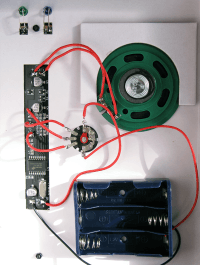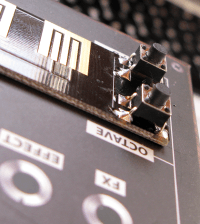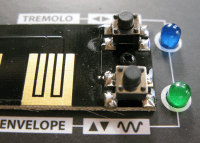Review: Mini synthesizer kit
Aimed at the beginner
 The assembly is easy, as all the delicate components are on the supplied printed circuit board. You only have to solder 4 push buttons, 2 LEDs, the loudspeaker and the potentiometer, following the explanations in the guide. Even taking some time to read the instructions and get good solder joints, this will take less than an hour.
The assembly is easy, as all the delicate components are on the supplied printed circuit board. You only have to solder 4 push buttons, 2 LEDs, the loudspeaker and the potentiometer, following the explanations in the guide. Even taking some time to read the instructions and get good solder joints, this will take less than an hour.No need for special tools: side cutters, tweezers, soldering iron, Philips screwdriver and a few drops of glue are all you will need. Oh yes, you’ll also need three AA (1.5 V) batteries to power the circuit of this little digital musical instrument. And it works! If perchance the loudspeaker stays quiet, the manual gives precise indications of the probable causes.
 Once powered up, the mini synth does what it says: the notes of the major key of two octaves. To change from one octave to the other, you have to press the “Octave” button and leave it pressed. The same with the other button, marked # and b, to get sharps and flats. All this works exactly as the manual says, but to make music needs a skill which I didn’t quite get. Usually I am fairly open; anything that makes sounds and can be hacked fascinates me. Here, there is no way to play a tune other than in the major key, and also within the limits of one octave.
Once powered up, the mini synth does what it says: the notes of the major key of two octaves. To change from one octave to the other, you have to press the “Octave” button and leave it pressed. The same with the other button, marked # and b, to get sharps and flats. All this works exactly as the manual says, but to make music needs a skill which I didn’t quite get. Usually I am fairly open; anything that makes sounds and can be hacked fascinates me. Here, there is no way to play a tune other than in the major key, and also within the limits of one octave.And the music?
 It’s with tremolo and envelope effects that it can… or could become interesting and instructive in the musical realm. Doesn’t the modification of sounds with a synthesizer consist primarily in modifying their pitch (frequency) and their volume (amplitude)? This is what the two buttons to the right of the keyboard are supposed to do; two incremental controls, in steps from 1 to 10. Alas, on the 11th press, you return suddenly from the maximum to zero, which is a bit illogical musically.
It’s with tremolo and envelope effects that it can… or could become interesting and instructive in the musical realm. Doesn’t the modification of sounds with a synthesizer consist primarily in modifying their pitch (frequency) and their volume (amplitude)? This is what the two buttons to the right of the keyboard are supposed to do; two incremental controls, in steps from 1 to 10. Alas, on the 11th press, you return suddenly from the maximum to zero, which is a bit illogical musically.This is really a pity, because if, instead of these unsuitable push buttons, the designer had used 2 adjustable knobs or potentiometers, these two effects would have been far more musically satisfactory.
Note here that often, the words tremolo and envelope are used in their opposite senses. what is called tremolo is, in terms of electronic magic a vibrato (= slight modulation of frequency) and what is termed envelope is in fact a... tremolo (= amplitude modulation). In instrumental music, tremolo designates a type of ornamentation…. But let’s leave these finer points.
Read full article
Hide full article


Discussion (0 comments)